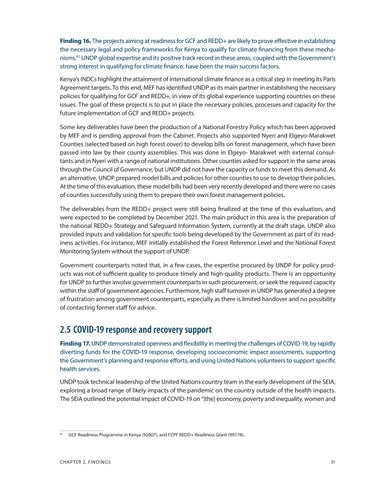Finding 16. The projects aiming at readiness for GCF and REDD+ are likely to prove effective in establishing the necessary legal and policy frameworks for Kenya to qualify for climate financing from these mechanisms.61 UNDP global expertise and its positive track record in these areas, coupled with the Government’s strong interest in qualifying for climate finance, have been the main success factors. Kenya’s INDCs highlight the attainment of international climate finance as a critical step in meeting its Paris Agreement targets. To this end, MEF has identified UNDP as its main partner in establishing the necessary policies for qualifying for GCF and REDD+, in view of its global experience supporting countries on these issues. The goal of these projects is to put in place the necessary policies, processes and capacity for the future implementation of GCF and REDD+ projects. Some key deliverables have been the production of a National Forestry Policy which has been approved by MEF and is pending approval from the Cabinet. Projects also supported Nyeri and Elgeyo-Marakwet Counties (selected based on high forest cover) to develop bills on forest management, which have been passed into law by their county assemblies. This was done in Elgeyo- Marakwet with external consultants and in Nyeri with a range of national institutions. Other counties asked for support in the same areas through the Council of Governance, but UNDP did not have the capacity or funds to meet this demand. As an alternative, UNDP prepared model bills and policies for other counties to use to develop their policies. At the time of this evaluation, these model bills had been very recently developed and there were no cases of counties successfully using them to prepare their own forest management policies. The deliverables from the REDD+ project were still being finalized at the time of this evaluation, and were expected to be completed by December 2021. The main product in this area is the preparation of the national REDD+ Strategy and Safeguard Information System, currently at the draft stage. UNDP also provided inputs and validation for specific tools being developed by the Government as part of its readiness activities. For instance, MEF initially established the Forest Reference Level and the National Forest Monitoring System without the support of UNDP. Government counterparts noted that, in a few cases, the expertise procured by UNDP for policy products was not of sufficient quality to produce timely and high-quality products. There is an opportunity for UNDP to further involve government counterparts in such procurement, or seek the required capacity within the staff of government agencies. Furthermore, high staff turnover in UNDP has generated a degree of frustration among government counterparts, especially as there is limited handover and no possibility of contacting former staff for advice.
2.5 COVID-19 response and recovery support Finding 17. UNDP demonstrated openness and flexibility in meeting the challenges of COVID-19, by rapidly diverting funds for the COVID-19 response, developing socioeconomic impact assessments, supporting the Government’s planning and response efforts, and using United Nations volunteers to support specific health services. UNDP took technical leadership of the United Nations country team in the early development of the SEIA, exploring a broad range of likely impacts of the pandemic on the country outside of the health impacts. The SEIA outlined the potential impact of COVID-19 on “[the] economy, poverty and inequality, women and
61
GCF Readiness Programme in Kenya (92607), and FCPF REDD+ Readiness Grant (99178).
CHAPTER 2. FINDINGS
31



